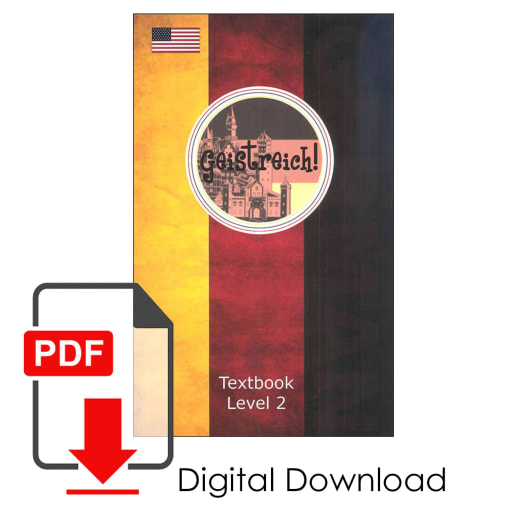This is the digital version of the Level 2 Brilliant! German Textbook for you to print yourself or read on a computer/tablet. This is not interactive. Your initial access instructions are emailed from services@rainbowresource.com within 24 hours. Have patience as the publisher site is a bit round about in how you access the content. ~Sara
Brilliant! German Level 2 Textbook PDF Download
Product Overview
Description
Geistreich! (Brilliant!) German is a charming program to introduce your children to the German language. You can start at any point between kinder and Grade 4. The publisher suggests using the textbook with a student starting in 1st grade and adding the workbook once your child is reading/writing in their first language well (about 2nd grade.) So, to implement the whole course simultaneously, begin with students in 2nd to 4th grades. Younger students (K-2) can use the course without reading and writing.
- German has 2 levels available
- Textbook is a small-format (5.5"x 8.5"), spiral-bound print book with 96 units and a pronunciation guide. Several of the units actually review previous lessons (e.g. units 6, 9, 12, 15, 18, 21 & 24 are all reviews, followed by a review week (units 25-27). The lessons are pretty short, 1-4 pages, and instructions are in English. A good schedule would be a unit per day (3 days a week) for 32 weeks.
- Textbook is also available as a PDF download
- Workbook has 1 page of practice per unit and is also available as a PDF
- Audio portion is available on CD or as an MP3 download
- Flashcards are optional, but kids enjoy them!
- Light bundle includes the textbook, workbook and CD (choose print books/CD or all digital)
- Full bundle includes the textbook, workbook, CD and all 4 sets of flashcards (books in print only)
Unit 1 covers greetings (good morning/day/evening/night). You use the audio CD/download here to model the correct pronunciation and accent (the audio also has 96 units). The speaker on the disc talks pretty fast, but it is easy enough to listen to it several times. Then, you learn to say yes/no. The teacher asks the student several questions in English and the kids respond with ya/nein. For example: Do you like apple pie? Ja! Adding to the theme here, kids are asked: Would you like...? and have to answer with Ja, bitte (yes, please) or Nein, danke (no, thank you). Students are encouraged to use these phrases throughout the day. Doesn't that sound like an easy way to teach and learn German? I think so!
The flashcards add a fun,
interactive, colorful opportunity for language practice outside of the lessons.
One side has a colorful illustration with the word printed very small in
English. On the back is the German word in large, bold black type on a white
background. There are 4 different packs, A-D, each pack with 52 cards
(5.75"x 3.5"). Use them to reinforce vocabulary, practice
pronunciation and even come up with your own games! ~Sara
| Product Format: | Other |
|---|---|
| Grades: | K-4 |
| Brand: | Brilliant! Foreign Languages |
| EAN/UPC: | xxxx947180352 |

